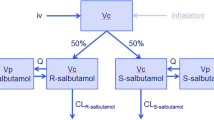Summary
Sustained release (SR) oral theo-phylline preparations have been used in the long term treatment of obstructive airways disease (OAD) in increasing numbers of patients in recent years. The maximum bronchodilatation is achieved with serum theophylline levels of 10–20 ug/ml; if this upper level is exceeded serious toxic effects may develop. This paper reports the measurement of drug levels in three groups: (a) 8 patients on long-term therapy with SR theophylline who presented to the emergency department with acute exacerbation of their OAD (mean level 18.2 ug/ml SEM ± 10.7 ug/ml); (b) 20 patients on long-term therapy who attended for routine outpatient follow-up (mean 6.4 ug/ml SEM ± 0.9 ug/ml); (c) a group of 3 hospital in-patients and 7 healthy volunteers on supervised therapy (mean peak level 11.8 ± 1.1 ug/ml and mean trough level 7.0 ± 1.3 ug/ml).
It is concluded that the attainment of satisfactory serum levels on supervised therapy is not sufficient grounds for assuming that this will not be maintained in the long term and that serum levels measured as an out-patient may be helpful in assessing compliance and dosage adequacy. It is confirmed that acutely ill patients may have levels within or above the therapeutic range and that they may be exposed to toxic effects if intravenous aminophylline is routinely administered in the emergency department.
Similar content being viewed by others

References
Friend, J. A. R. 1979. Theophylline levels in patients receiving a controlled-release aminophylline preparation. J. Int. Med. Res. 7, Suppl. 1, 67.
Gately, M S. 1968. To be taken as directed. J. Roy. Coll. Gen. Practit. 16, 39.
Gushaw, J. B., Hum, W., Singh, P., Miller, J. G., Schneider, R. S. 1977. Homogenous enzyme immunoassay for theophylline in serum. Clin. Chemistry 23, 1144.
Jacobs, M. H., Senior, R. M., Kessler, G. 1976. Clinical experience with theophylline relationships between dosage, serum concentration and toxicity. J. Am. Med. Assoc. 235, 1983.
Mitenko, P. A., Ogilvie, R. J. 1973. Rational intravenous doses of theophylline. N. Eng. J. Med. 289, 600.
Piafsky, K. M., Ogilvie, R. I. 1975. Dosage of theophylline in bronchial asthma. N. Eng. J. Med. 292, 1218.
Trembath, P. W., Boobis, S. W., Richens, A. 1979. Theophylline biochemical pharmacology and pharmacokinetics. J. Int. Med. Res. 7, Suppl. 1, 4.
Turner Warwick, M. 1957. Study of theophylline plasma levels after oral administration of new theophylline compounds. Br. Med. J. 2, 67.
Author information
Authors and Affiliations
Rights and permissions
About this article
Cite this article
Laher, M.S., O’Regan, P., Jackson, F. et al. Serum theophylline — A mandatory measurement in the control of therapy?. I.J.M.S. 154, 193–197 (1985). https://doi.org/10.1007/BF02937360
Issue Date:
DOI: https://doi.org/10.1007/BF02937360



